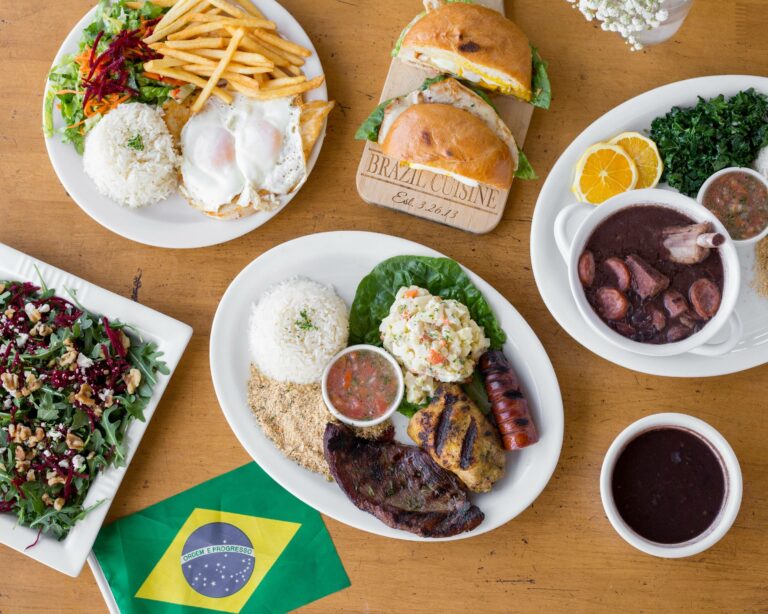Introduction: The Rich and Diverse Flavors of Brazilian Cuisine
Brazilian cuisine is a delicious blend of indigenous, African, and European influences, resulting in a diverse and flavorful culinary landscape. The country’s vast size and regional differences have given rise to many distinct regional cuisines, each with its own unique ingredients and preparation methods. From the Amazon rainforest to the coast and the countryside, Brazilian cuisine incorporates a wide range of local ingredients that make it truly unique.
Rice and Beans: The Staple Ingredients of Most Brazilian Dishes
Rice and beans are the staple ingredients in most Brazilian dishes and are often eaten twice a day. The combination is called “arroz e feijão” in Portuguese and is typically served as a side dish alongside grilled meat or fish. The beans used in Brazilian cuisine vary depending on the region, and some popular varieties include black beans, carioca beans, and feijão fradinho. Rice is usually cooked with garlic and onions, giving it a delicious aroma and flavor.
Cassava: A Versatile Root Vegetable Used in Many Forms
Cassava, also known as yucca or manioc, is a root vegetable that is a staple in Brazilian cuisine. It is used in many different forms, including tapioca flour, which is used to make the popular snack “pão de queijo” (cheese bread). Cassava is also used to make “farofa,” a crunchy side dish made with toasted manioc flour. In the northeast region of Brazil, cassava is used to make “carne de sol,” a popular dish made with salted and sun-dried beef.
Açaí: The Superfood from the Amazon Rainforest
Açaí is a superfood that comes from the Amazon rainforest and has gained popularity worldwide due to its health benefits. In Brazil, it is commonly consumed as a smoothie bowl or juice and is often topped with granola and sliced fruits. Açaí berries are known for their high antioxidant content and are said to have anti-inflammatory properties. In addition to being a nutritious food, açaí is also an important ingredient in cosmetics and personal care products due to its skin-protective properties.
Farofa: The Crunchy and Flavorful Side Dish
Farofa is a crunchy side dish made with toasted manioc flour and is a staple in Brazilian cuisine. It is typically seasoned with garlic, onions, and bacon, and is often served with grilled meat or fish. Farofa can also be made with other ingredients such as egg, olives, and herbs, giving it a unique flavor and texture. It is a versatile dish that can be adapted to different tastes and preferences.
Feijoada: The Iconic Brazilian Pork and Bean Stew
Feijoada is an iconic Brazilian dish that is often considered the country’s national dish. It is a stew made with black beans and pork, including different cuts of meat such as bacon, sausage, and pork belly. Feijoada is typically served with rice, farofa, and orange slices, and is a hearty and flavorful meal that is perfect for cold days. Although it originated in Rio de Janeiro, feijoada is now popular throughout Brazil and is often served at family gatherings and celebrations.
Tapioca: The Gluten-Free Flour Made from Cassava
Tapioca is a gluten-free flour made from cassava and is a popular ingredient in Brazilian cuisine. It is used to make “tapioca crepes,” a type of pancake that is commonly filled with cheese and ham. Tapioca flour is also used to make “beiju,” a small flatbread that is often eaten as a snack. Tapioca is a versatile ingredient that can be used in both sweet and savory dishes, making it a popular choice for those with gluten sensitivities.
Cachaça: The Popular Spirit Used in Caipirinhas and Cooking
Cachaça is a popular spirit in Brazil that is made from fermented sugarcane juice. It is the main ingredient in the famous Brazilian cocktail “caipirinha,” which is made with cachaça, lime, and sugar. Cachaça is also used in cooking, particularly in marinades and sauces for grilled meats. It is a versatile spirit that adds a distinct flavor to many Brazilian dishes and is loved by locals and visitors alike.

